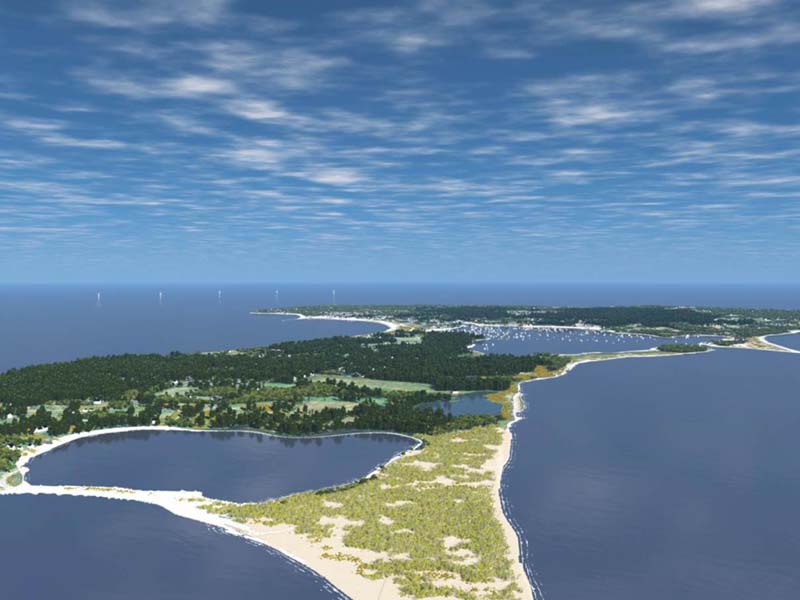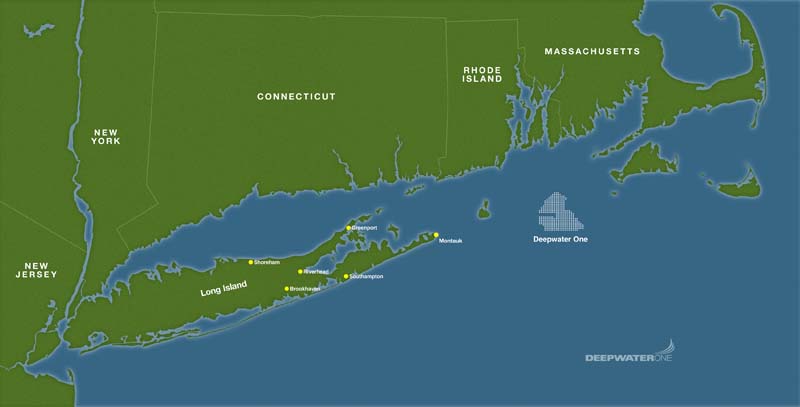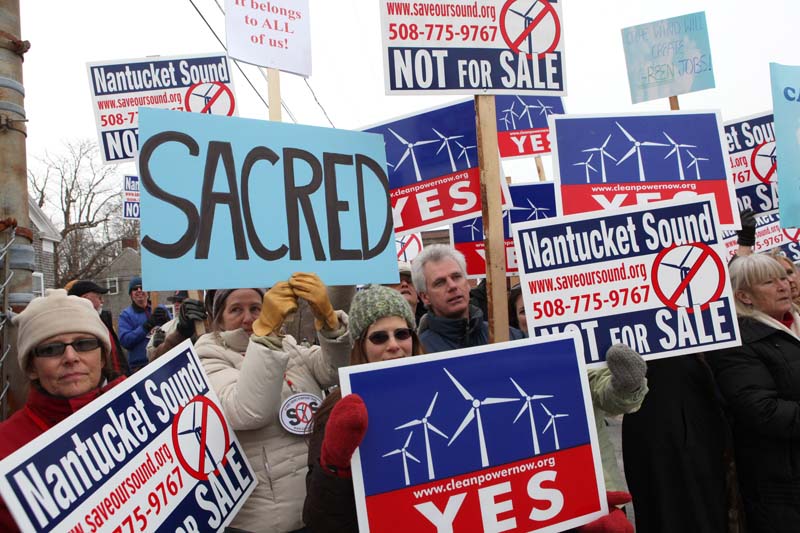By: Keith Martin, Partner, Chadbourne & Parke LLP
Deepwater Wind has a $290 million, 30-megawatt (MW) project under construction in the Atlantic Ocean 3 miles from Block Island off the coast of Rhode Island. The project will use 5 Haliade™ 150-6 MW offshore wind turbines built by Alstom.
Cape Wind came very close to closing on the financing for the $2.5 billion, 364-MW first phase of a 468-MW wind farm in Nantucket Sound near Martha’s Vineyard off the Massachusetts coast. When the financing failed to close by December 2014, the two utilities that agreed to buy the electricity from the project under long-term contracts cancelled the contracts. Cape Wind asserts that it is entitled to an extension of the construction-start deadline in the contracts due to force majeure: the prolonged litigation that the project has endured from opponents.
Talks with the developers, lenders, and equity investors involved with the two projects as well as with other less advanced projects suggest more than a dozen lessons for anyone attempting another such project in the future. Chadbourne acted as counsel to the lenders on the financing for Block Island and as financing counsel to the developer of Cape Wind. This article takes a look at several of the key lessons to emerge from the offshore wind projects that have been attempted to date in the United States.
Lessons about Scale and Timing
Block Island demonstrates that it may be better to make the first project a small project as a proof of concept before moving to a larger scale. A developer should consider developing a large project in legally separated phases to allow for financing of manageable tranches. This approach requires smart planning during project development in lease negotiations; interconnection queue requests; and negotiation of the framework turbine supply agreement, foundation installation contract, cable and boat contracts, and power purchase agreements. Developing a project this way does not preclude a single large portfolio financing later if market conditions permit.

Artist rendition of what the five offshore turbines off Block Island could look like once completed. Steel went into the water for this project in July 2015. Image credit: Deepwater Wind.
These are already complicated projects because of the number of contractors involved. A large and expensive project requires lots of financing parties, increasing the difficulty of holding everything together.
Offshore wind projects are intensely political. The high capital cost per installed megawatt means the projects rely on political support to get done. Both Block Island and Cape Wind had power purchase agreements that paid the projects more than $200 per MWh. Such contracts require support from the governor and state public utility commission to pass through the wholesale power price in rates.
Move as quickly as possible though the development process. There is no time to spare. The longer the development cycle, the more likely the politics are to change and for a smaller developer to run out of money. Cape Wind saw Deval Patrick (D), who was a strong supporter of the project, leave office at the end of 2014 to be replaced as Massachusetts Governor by Charlie Baker (R) who opposed the project in the past and has, at best, a hand’s-off policy about the project, viewing it as a private contracting dispute between the developer and the utilities. Chris Christie (R) called in 2010 for turning New Jersey into a wind superpower, seemingly to lose interest around the time he started running for president, leaving a pilot wind farm proposed by Fishermen’s Energy off Atlantic City to struggle.
Once the project moves into financing, move rapidly to find common ground and not let negotiations bog down. Well-funded and determined opposition groups can kill a project. Avoid choosing a site that invites well-financed opposition. The latest offshore sites that the federal government has been putting out for lease are likely to face less interference because they are farther from shore.
Offshore wind projects involve multi-contract construction arrangements. The projects are not like conventional power projects on land where there is a fixed-price, turn-key construction contract for the entire project under which the EPC contract “wraps” construction by warranting that all the project components will work together when the power plant is fully assembled. An onshore wind farm usually has two contracts: a turbine supply agreement and a balance-of-plant construction contract. With offshore wind, there is not one or even two contractors who take responsibility for the entire project. It is important to make sure everything fits together in terms of risk coverage, timing, damages, who pays what to whom, and what happens if there are delays in construction.
Both Block Island and Cape Wind proved that lenders can get comfortable with the multi-contract construction arrangement and some legal challenges. The Block Island financing closed with such an arrangement, and the senior lenders were prepared to close on Cape Wind, helped by a $150 million loan guarantee that was expected from the U.S. Department of Energy. The DOE was not taking first loss, but its presence was a form of political risk insurance.

Deepwater Wind has a $290 million, 30-megawatt (MW) project under construction in the Atlantic Ocean 3 miles from Block Island off Rhode Island. The project demonstrates that it may be better to develop a small proof of concept scale before moving to a larger scale.
Lessons About Financing
Offshore wind farms take a long time to construct. Deepwater has a 22-month construction cycle; the project is expected to be in commercial operation in late fall 2016. Cape Wind was not expected to come on line until sometime in 2017 if the financing had closed by December 2014.
The long construction period means that it will be impossible to get a forward tax equity commitment at closing on the construction financing. It is difficult to secure tax equity commitments at construction closing more than a year in advance. Therefore, an alternate takeout will have to be negotiated for the construction debt in case tax equity cannot be arranged.
Developers might consider working with institutions that have both construction financing and tax equity capacity, but the list of such institutions is short. There is plenty of interest. At least 20 to 25 banks are potential lenders. The risk premium is only about 25 basis points over bank debt for onshore wind farms. Add another 25 basis points for other factors like litigation. Plan for a debt tenor of construction plus 5 to 7 years with mini-perm features and a term debt equity ratio of 70-30. Lenders are willing to treat subordinated mezzanine debt as equity for this purpose. For comparison, onshore wind farms can reach debt equity ratios of 90-10.

Cape Wind stalled when two utilities terminated agreements to buy energy from the wind farm after Cape Wind missed a December 2014 deadline to obtain financing. Cape Wind cited ongoing litigation as a reason to extend the deadline. Photo credit: WBUR, Boston.
The much smaller pool of potential equity investors in U.S. offshore wind projects means that equity can be very expensive. Given the inability to line up tax equity at construction financing, it is better to find equity investors who can use the tax benefits themselves. The need for project-level debt means that the pool of potential traditional tax equity investors is likely to be very small. It is rare today to find mainstream tax equity investors who are willing to do partnership flip tax equity deals with project-level lenders who come ahead of the tax equity in the capital structure; most debt today is back-levered debt at the level of the sponsor that is behind the tax equity in line. Leveraged flip deals require an agreement with the senior lenders on forbearance: the tax equity will want the lenders to agree not to foreclose on the project for a period of time to let the tax equity investors reach their target yields. The market consensus on forbearance terms appeared to collapse in 2014 after K-Road was unable to close a leveraged partnership flip transaction it had fully negotiated after inability to reach agreement on forbearance. Debt is easier to combine with tax equity in sale-leaseback transactions, but sale-leasebacks are not possible in wind projects unless the project claims a 30% investment tax credit on the project cost rather than production tax credits of $23/MWh, adjusted for future inflation, on the first 10 years of electricity output.
The high capital cost may make these investment tax credit deals rather than production tax credit transactions, but the scale of the investment credits on larger projects could require clearing the tax equity market. The investment credit is claimed entirely in the year the project is placed in service, placing greater demands on available tax capacity, rather than spreading the needed tax capacity in smaller increments over each of the first 10 years of commercial operation. The investment tax credit being projected on Cape Wind in late 2014 was $600 million, a market-clearing figure. On the other hand, a tax equity investor relying on production tax credits is taking 10 years of operating risk while the full investment credit is locked in at inception when the project is put in service.
Seventeen offshore wind projects have been financed to date in Europe. Scale eventually brings down costs, but the scale economies in Europe have not translated fully into lower costs in the United States, in part because the United States lacks the port, vessel, and other infrastructure required to install and maintain offshore wind turbines.
Other Lessons
U.S. laws and inexperience impose premiums. The Jones Act and Cargo Preference Act may add as much as 50% to transportation costs. The marine construction industry, ports, insurance, and the financial markets all charge risk premiums for offshore wind farms. The whole infrastructure of ships and ports that supports European offshore wind has to be replicated in the U.S.
The premiums should start to shrink once there is an operating history for Block Island. U.S. companies have some related experience that can be transported to offshore wind. It was an “aha moment” for the banks in Cape Wind to realize that installation of monopiles for the turbines is nothing more than driving a pipe into the seabed with a hydraulic hammer, a task that U.S. companies do when building bridges and LNG terminals, and there are numerous U.S. submarine transmission cables. Crane and maintenance barges may be hard to find. A project the size of Cape Wind could build its own; smaller projects have to work within the parameters of what is available on the east coast.
The U.S. permitting process can also be a barrier to reducing costs. The Cape Wind permits were obtained well before financing and required the project to use 2002 technology. Reopening the permits would have been an 18-month process at least and would have reopened the project to more legal challenges.
The shortage of U.S. vendors, ships, and equity means all such parties can charge premiums. A turbine vendor will not do cost-plus for turbines. It will insist on value pricing.
Regulatory risk and uncertainty around subsidies in the United States add costs. Tax credits for wind projects expire and are renewed in 1- and 2-year intervals. It is hard to accomplish something novel and complex in the face of an uncertain subsidy regime. Even if the subsidy were certain, the uncertainty around the ability to raise tax equity significantly erodes the pricing the project will find on offer from potential equity investors since such investors assign less value to the investment.
Finding the development staff with the right experience can be a challenge. The multi-contract construction structure is not a skill set that onshore wind companies have. It would be a good idea to hire an experienced offshore construction team early in the process, though it will have to be found in Europe or in the offshore construction field in the Gulf of Mexico. One potential bright spot is that equipment vendors and vessel companies may reach saturation or face a slowdown in Europe and start looking to the U.S. for growth.
It is best to use the largest turbines and put them as high up and far out as possible to spread the higher cost per foundation and labor in the water on land over a larger output. Cape Wind has a 38% capacity factor in Nantucket Sound versus 48% for Block Island in the unobstructed ocean.
Keith Martin is a transactional lawyer whose principal areas of practice are tax and project finance. He acted for 178 companies last year and worked on transactions in the United States and eight foreign countries. Based in Washington, D.C., he also lobbies Congress and the Treasury Department on policy issues. He is co-head of the Chadbourne Project Finance Group. The prestigious Chambers Directory in London ranks Chadbourne at the top of United States law firms working in the renewable energy sector. Mr. Martin is also the editor of the Project Finance Newswire, where a version of this article first appeared in September 2015. It is reproduced here with slight modifications and with permission. For more information, visit www.chadbourne.com/renewable-energy.




